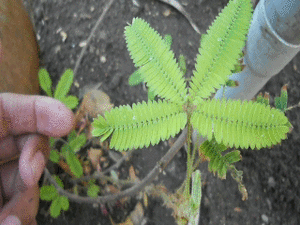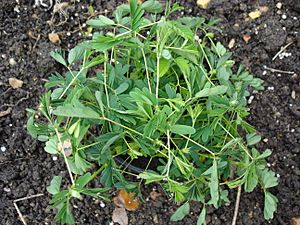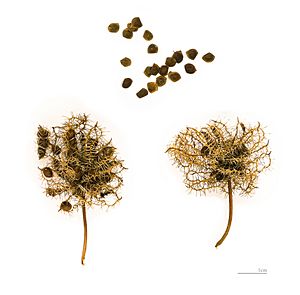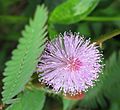Mimosa pudica facts for kids
Quick facts for kids Mimosa pudica |
|
|---|---|
 |
|
| Mimosa pudica | |
| Scientific classification | |
| Kingdom: | |
| (unranked): | |
| (unranked): | |
| (unranked): | |
| Order: | |
| Family: | |
| Subfamily: | |
| Genus: | |
| Species: |
M. pudica
|
| Binomial name | |
| Mimosa pudica |
|
Mimosa pudica is a super cool plant, often called the "sensitive plant" or "touch-me-not." It's famous for its amazing trick: its leaves quickly fold up and droop when you touch them, shake them, or even blow on them! A few minutes later, they slowly open back up. This plant originally comes from places like South America and Central America, but now you can find it growing in many parts of the world.
Contents
What Does the Sensitive Plant Look Like?
The Mimosa pudica plant starts with a stem that stands straight up when it's young. As the plant gets older, its stem starts to creep or trail along the ground.
Leaves and Flowers
The leaves of the sensitive plant are special. They are made up of many tiny leaflets arranged in pairs, like feathers. Each leaf can have one or two pairs of these main branches, and each branch has between 10 and 26 small leaflets.
The flowers grow in round bunches, called flower heads, which are about 8 to 10 millimeters wide. The top part of the flower petals is red, and the thin threads (called filaments) are pink to purple.
Fruits and Seeds
After the flowers, the plant grows fruit. These fruits are like small pods, with 2 to 8 pods growing in a cluster. Each pod is about 1 to 2 centimeters long.
The pods break into smaller pieces, and inside are pale brown seeds, each about 2.5 millimeters long. Wind and insects help pollinate the flowers, which means they help the plant make seeds. The seeds have tough outer coats, which can make it a bit hard for them to sprout.
How the Sensitive Plant Moves
Mimosa pudica is really famous for how fast its leaves move. It's not the only plant that moves, but it's one of the quickest!
Sleeping Leaves
Just like some other plants, the sensitive plant's leaves also "sleep." This means they close up when it gets dark and then open again when the light returns. It's like the plant is taking a nap!
Why the Leaves Close
The leaves also close when they are touched, warmed, blown on, or shaken. When something disturbs the plant, special areas on its stems release tiny particles called potassium ions. This makes water move out of the plant's cells.
When the water leaves the cells, they lose their firmness and become soft. This change in firmness makes the leaflets fold inward and the main leaf stalk (called a petiole) droop down. This amazing trick is common in the Mimosoideae group of plants, which are part of the larger Fabaceae family (also known as the legume family).
Why Does It Move?
Scientists are still learning exactly why the sensitive plant moves so quickly. One idea is that it's a way to protect itself from animals that might want to eat it. An animal might get scared by a plant that suddenly moves and decide to find a less active snack!
Another idea is that the sudden movement helps shake off harmful insects that might be trying to land on or eat the plant. It's like the plant is trying to shoo them away!
Images for kids
See also
 In Spanish: Mimosa pudica para niños
In Spanish: Mimosa pudica para niños






